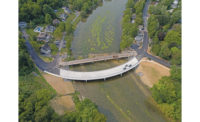Glancing over HDR's financial results in Texas and Louisiana in recent years, one wouldn't know there was a recession going on. The full-service architecture and engineering firm, which has 16 offices in the region, has steadily grown through the down economy, more than doubling its regional revenue since 2007. A combination of sound business strategies, motivated employees and good luck catapulted the firm to the top of ENR Texas & Louisiana's annual Top Design Firms ranking for the first time. In light of the firm's noteworthy achievements, HDR is named ENR Texas & Louisiana Design Firm of the Year.
Ramon Miguez, engineering department manager for HDR in Dallas, is quick to credit his employees for the firm's success. Such praise might sound like a canned response coming from most executives, but as a global employee-owned firm, HDR has a staff highly motivated to keep the firm pushing ahead.
"I truly believe that the biggest differentiator is our ownership model," he says. "The vast majority of employees are stockholders and only employees can be stockholders. Every one of us has a vested interest in making sure we succeed."
And succeed HDR did. In 2007, the company reported $73.5 million in regional revenue. Since then, revenue has grown steadily by double-digit figures, reaching $165.75 million in 2011.
Heidi Higgason, HDR vice president and director of operations in the South Region, agrees that employees "buckled down and worked harder" as the recession hit, but acknowledges that fortunate timing played a big part in the equation as well. Substantial projects awarded to HDR were funded before the recession hit, including the $481-million-Ambulatory Care Center at the Lackland Air Force Base in San Antonio and the $1.3-billion Parkland Hospital replacement project in Dallas, one of the largest hospital projects in the U.S.
"That kept us busy for a while when others had no work," she says. "That was the underlying positive that we could build everything else on. We weren't focused entirely on there being no work. We had large projects sustaining us while the crunch happened."
Right Place, Right Time
Some sound strategies also positioned the firm to benefit from good timing. Higgason notes that in the years prior to recession, HDR focused on establishing its position in the federal market. "We realized that we needed to build a stronger relationship with the Department of Defense," she says. "It built us up to the point where we earned trust on a number of large projects right when it mattered most."
The Ambulatory Care Center at Lackland was not only a financial success; it was also selected to receive an award for concept design in the 2011 U.S. Air Force design competition. When completed, the 680,000-sq-ft center will become the largest ambulatory-care surgical center in DOD.
With the Lackland project already under construction, HDR is currently finishing design work on the $1-billion William Beaumont Army Medical Center replacement hospital at Fort Bliss in El Paso. That project is scheduled to open in 2016.






Post a comment to this article
Report Abusive Comment